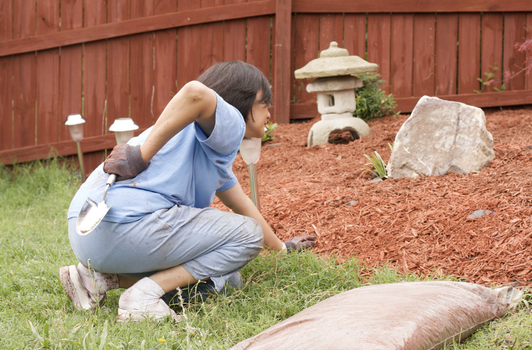How Soon Is Too Soon to Resume Activities with Back Pain?
Nov 09, 2022
A very common problem we see at Athletes’ Potential is low back pain. What comes with low back pain are a lot of questions about the best ways to manage the pain when it first occurs, as well as the best ways for our athletes to rehabilitate. What I want to focus on in this blog post is how important it is to get back to gentle activity sooner rather than later when dealing with low back pain.
A Timeline of Back Pain
T0: Back pain!
You feel a sharp ache in your lower back. You may have been lifting something heavy or you may have been reaching for your shoes. Back pain can come about for a variety of reasons! Whatever the case… your back “went out.”
No matter the presence or absence of pathology (disc irritation, facet irritation, muscle strain, etc.), your brain and nervous system are going to go into overdrive trying to protect your back. This is where many people will experience a tightening sensation or spasms in their lower back. This is a normal, protective mechanism! Your brain is doing its best to shield you from further motion by tightening up all the musculature in your back.
Thank you, brain!
This phase is known as the “acute” phase of pain. Typically this lasts for a day or two. It's where pain is the worst and rest is indicated. The goal of this stage is to get the pain to stabilize. When I say “stabilize” I mean that it still might be quite painful, but you are able to do more than you previously could, such as get out of bed and do short walks, where before that was near impossible due to the rapid, sharp pain that occurs with motion.
Many athletes believe that rest is best at this phase, but many studies suggest the opposite. In a 2018 review of best practices surrounding low back pain, 6 out of 11 studies support avoiding bed rest during acute bouts of low back pain, four studies were inconclusive, and only one suggested bed rest.1
Great news! Get active as soon as you are able. At this point, it's best to work on breathing exercises, gentle core exercises such as bracing and bridges, and try to get on your feet when tolerable.
If this is unsuccessful and your high level of pain is lasting for more than three days, I would contact us at Athletes’ Potential or your PCP for further assessment and treatment.
Once the pain begins to stabilize, and you’re able to do some gentle activities as tolerated, you’ve entered the subacute phase.
T1: Less Back Pain!
You’re feeling slightly better but you’re still hesitant to do anything beyond baseline. You would like to get back to your workouts, your sport, or just simply getting into and out of a car without increased ache. This is the subacute phase and is also where physical therapy is incredibly helpful in accelerating your rehabilitation.
In lieu of physical therapy, this is where so many athletes choose one of two directions:
- Continue resting; only do things when absolutely needed such as go to the bathroom or the kitchen; hope for the best.
- Attempt to do things beyond baseline as tolerated throughout the day, such as going on a walk, or maybe even doing a light workout just to test out how your back is doing, such as gentle core exercises or stretches.
Luckily, we have a good bit of evidence supporting option number two. Those that choose light activity as compared to bed rest have a statistically significant improvement in their overall recovery timeline as supported by a cochrane review of the literature2.
Once again, get active. Do a light workout as tolerated. Listen to your symptoms and stay within what your body is telling you. If you want guidance, reach out! This is what Athletes’ Potential is here for!
Hopefully by day 5-10, you’ve slowly progressed back to a reasonable level of capacity.
T2: Light to Moderate Activity
Once again, this is where physical therapy at Athletes’ Potential excels!
You’re feeling better but just need a bit more guidance to push you over the edge to get back to your activity or sport.
Core stabilization, strength training, and flexibility drills are all part of this phase. This is where we can really make some quick strides in your recovery.
–
I won’t go into this last phase too much, as this phase isn’t the intent of this blog.
Overall, I want readers of this post to know that if they are having an acute bout of back pain, stay gently active as tolerated! Don’t go out and progress too fast, and don’t ignore your back pain. Listen to what it's telling you.
If it's slowly getting better, go do things such as walks, light exercise, and gentle stretching. And if you ever need guidance with this recovery, feel free to reach out to us at any time!
Thanks for reading,
Dr. Marcus Rein PT DPT
Physical Therapist
Athletes’ Potential
- Oliveira CB, Maher CG, Pinto RZ, Traeger AC, Lin CC, Chenot JF, van Tulder M, Koes BW. Clinical practice guidelines for the management of non-specific low back pain in primary care: an updated overview. Eur Spine J. 2018 Nov;27(11):2791-2803. doi: 10.1007/s00586-018-5673-2. Epub 2018 Jul 3. PMID: 29971708.
- Hagen KB, Jamtvedt G, Hilde G, Winnem MF. The updated cochrane review of bed rest for low back pain and sciatica. Spine (Phila Pa 1976). 2005 Mar 1;30(5):542-6. doi: 10.1097/01.brs.0000154625.02586.95. PMID: 15738787.
Let us help you figure out to live your best active life today!
Remember, Movement is Medicine!

